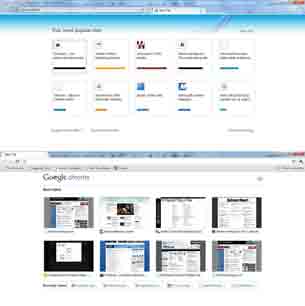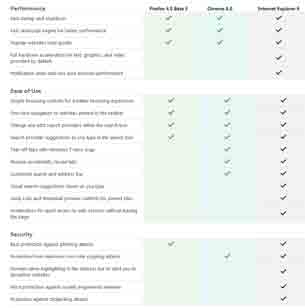In-Depth
Inside IE 9: The Chrome Effect
The beta of IE 9 is more than just a browser for Microsoft -- it's a direct shot in its war against Google, and it shows.
The beta of Internet Explorer 9 was released on Sept. 15, amidst much fanfare, at Microsoft's launch event in San Francisco. It's a Web browser, but the release also signals Microsoft's future direction, as well as the fate of its Windows cash cow. Much may rest on IE 9's success.
Microsoft was hardly keeping the details about IE 9 a secret. The company has been publicizing its IE 9 engineering efforts with a PR blitz that started in March. It produced four "platform preview" prototypes of IE 9 before the beta release, which showcased early positive performance results.
Microsoft's platform preview tests typically showed IE 9 beating or equaling its browser competition. All that was missing from those IE 9 browser prototypes before the beta launch was security and user interface flourishes. Consequently, expectations were high that the IE 9 beta would live up to its hype when released.
With the beta now available, Microsoft appears to have made its case. IE 9 has the speed and ease-of-use qualities found in Google Chrome, but it offers greater security options for users. For instance, Microsoft has introduced a download manager in the IE 9 beta that alerts users when they may be about to click on a download deemed to be untrustworthy. The ponderous slowness of IE 8, which Microsoft typically blamed on third-party add-ons, is gone. Plus, Microsoft added a tool in the IE 9 beta that tells users when an add-on is causing a performance hits, enabling better user control over potential browser slowness issues.
Ideas Borrowed From Google Chrome
The IE 9 beta has a stripped-down or "minimalist" look, adopting some of the features seen in the Google Chrome browser. For instance, opening a new tab in IE 9 brings up a "popular sites" screen showing the logos of the most visited Web pages. The popular sites screen looks a lot like that same screen in Google Chrome, which is accessed in the same way. The one difference is that Google Chrome uses screenshots instead of the logo icons used in IE 9 beta (see Figure 1).

[Click on image for larger view.] |
| Figure 1. IE 9's use of logo icons. |
Another feature copied from Google Chrome is the "one box" address bar. Essentially, Microsoft removed the separate search text box seen in earlier IE releases. IE 9 beta users can type the URLs of Web pages in the address bar or they can type queries to search there, and one box "knows" the difference (see Figure 2). However, unlike Google's one box search, Microsoft's version doesn't always take the user to a search results page, making it far less useful. The IE 9 beta's one box frequently takes the user to a single Web page. So using the one box in IE 9 to search for "airplanes" takes the user to a B.o.B. music video site, whereas doing the same search using Google Chrome's single search box takes you to a search results page for "airplanes."

[Click on image for larger view.] |
| Figure 2. IE 9's "one box" address bar. |
One distinguishing aspect that Microsoft has emphasized with search in IE 9 is that users can limit the search engine from transmitting information to the search provider as the user types. Microsoft considers this to be a privacy violation, and has accused Google of unnecessarily invading user privacy by transmitting the query string in that way.
IE 9 Pluses and Minuses
Now that working copies of the new browser are available, it's time to look at Microsoft's promises and execution.
Microsoft provides a table listing the benefits it sees for the IE 9 beta over competing browsers, namely Firefox 4.0 Beta 3 and Chrome 6.0 (Opera is missing). The table shows big holes in terms of ease-of-use and security for the two competitors. In addition, Microsoft offers another table (see Figure 3) showing how the IE 9 beta beats out older Internet Explorer versions, zeroing in on IE 7 and IE 8.

[Click on image for larger view.] |
| Figure 3. Different Internet Explorer versions compared. |
One of the things to watch out for when opting to test the IE 9 beta is that installing it wipes out IE 8. You don't get a copy of IE 9 that runs alongside IE 8, as you did with the IE 9 platform previews. For some users, wiping out IE 8 may be a problem, although they could always try uninstalling IE 9 should things not work.
Another caveat is that the installation of IE 9 on a Windows 7 machine may seem a little more time consuming than expected. The install requires a reboot to take effect.
Microsoft itself has pointed out that the IE 9 beta currently has a problem working with Microsoft's Office Live Workspace, which is Microsoft's online document storage and sharing space. Users have been receiving error messages when trying to log into that site, according to a Microsoft blog post. The blog cites steps to get around the issue, but it also notes that Windows Live Workspace users will soon be transitioned to Windows Live Skydrive, a similar Web-based document storage solution that will offer up to 25 GB of space.
The issue of update control and maintaining support for legacy functionality is a serious one for many businesses. Microsoft's fidelity in giving IT pros ultimate control over whether to accept an update or not ensures that Internet Explorer will continue to be used by businesses and organizations. The flip side to such control is that when organizations decline to install browser updates, it can lead to serious security issues. Organizations still stuck on IE 6 have experienced this problem. For instance, Google's corporate headquarters reportedly had data stolen due to an IE 6 security hole, allegedly exploited by Chinese hackers.
IE 9 as a Windows "Feature"
Microsoft's perspective about its browser is different from that of the rest of the world. The world sees Internet Explorer as another program, but Microsoft long ago took the legal position (and settled a U.S. antitrust case over that issue in 1994) that Internet Explorer is a "feature" of Windows, as Microsoft CEO Steve Ballmer has described it.
As a Windows feature, IE 9 is oddly being launched separately from an actual Windows operating system launch. However, Microsoft has made it clear that IE 9 currently only works with Windows 7 and Windows Vista. It doesn't work with Windows XP, which currently is the most popularly used operating system in the world.
Microsoft is touting IE 9 user interface features as Windows features, and has been noting IE 9's integration with Windows 7. IE 9 is all about Windows, and Microsoft has been quite explicit in saying so. Its 93-page IE 9 beta product guide (8 MB download) tells that story.
"In designing Internet Explorer 9, we have optimized the browsing experience for the Windows customer," the guide states on page 9. "This focus has informed everything that we have done in planning, developing, and releasing the latest beta version of Internet Explorer."
To a certain extent, IE 9 is designed to get users hooked on the Vista/Windows 7 user "experience," which is Microsoft's nomenclature for "user interface." IE 9 incorporates several Windows-like features.
For instance, users can pin Web pages to the task bar in Windows 7/Vista, making Web pages appear as if they were frequently accessed applications in Windows (see Figure 4). These pinned sites display the logo of the Web page for easy recognition. Web site designers can design "jumplists" (Microsoft's term for a popup menu of links) that can be associated with these pinned sites to facilitate site navigation.

[Click on image for larger view.] |
| Figure 4. Pinning Web pages to the task bar. |
Microsoft has also enabled its Aero Snap Windows feature to work in IE 9. Aero Snap lets a user pull a browser tab out as a separate window and align it side-by-side with another window, making comparisons easier. Despite its name, the two windows did not "snap" into place -- I had to resize them. Google Chrome already has this sort of functionality. Firefox has long allowed users to pull tabs out, but it pulls them out as full-sized browsers, making sizing them down a little more tedious than with IE 9 and Google Chrome.
In an interview with CNet, Steven Sinofsky, president of the Windows and Windows Live Division, suggested that Microsoft only has to care about making IE 9 work with Windows. That fact makes design decisions easier for Microsoft compared with other browser makers, who have to design for OSes such as Linux or Mac OS. Sinofsky also suggested that IE 9 would have an "additive" positive effect on users when combined with the Windows 7 experience.
The Next Big Thing
Microsoft puts out a lot of free software and IE 9 is free, like competing browsers. Altruism isn't the reason for the company's generosity. Microsoft is simply keeping current with the latest developing Web technologies with IE 9. It has embraced the Web through Internet Explorer as part of the Windows experience -- a formulation that may not last the test of time.
For this release, Microsoft has stayed on the cutting edge and kept current with developing specs from standards bodies. The IE 9 beta was devised based on hundreds of tests that Microsoft's Internet Explorer team wrote to clarify the ambiguities of developing standards. Those tests address developing specs such as HTML 5, SVG 1.1, CSS 3.0, ECMAScript 5 and DOM L2 and L3. A lead product manager for Google's Chrome browser team even heaped praise on Microsoft effort to stick to standards, according to a Financial Times report.
The IE 9 beta taps into hardware-accelerated graphics, using a device's graphics processing unit, if present, to display scalable vector graphics. Microsoft added a new ECMAScript 5-based Chakra JavaScript engine that has shown performance results akin to other leading browsers. Microsoft moved JavaScript processing more into the DOM to achieve those faster results.
The IE 9 beta release simply reflects Microsoft's efforts to keep up with the competition. In the recent past, browsers such as Opera, Firefox and Chrome have typically led perceptions over Microsoft's IE 8 browser in terms of speed and standards support. With IE 9 beta, Microsoft hopes to stop a steady losing streak in terms of browser market share. For instance, Internet Explorer use has lost about one percentage point each month from July 2009 to April 2010, according to Net Applications. Meanwhile, Google Chrome has showed a slow but steady uptick in use. Google Chrome use has more than doubled since Oct. 2009, which is a feat equaled by no other leading browser, according to a Net Applications chart.
The release of the IE 9 beta likely will succeed in regaining that lost market share because Microsoft is at least equaling or exceeding its competitors in areas of dispute, such as browser speed and standards compliance. Microsoft is also projecting message to Web site developers that they can write code once and have it work across IE 9 and competing browsers -- a strong bonding point, and a break from the past with the quirky IE 6 release.
The IE 9 beta is more than just a free browser. It represents Microsoft's future survival ticket. The online world has become a primary destination for both business and consumer PC users. Microsoft has reoriented its product lines toward the Internet cloud, with Ballmer signaling Microsoft's "all-in" commitment back in March. Cloud interoperability has been the prime concern of Microsoft Chief Software Architect Ray Ozzie. However, the move toward the Web for Microsoft extends even further back.
A 1995 memo from then Microsoft CEO Bill Gates, "The Internet Tidal Wave," noted that Microsoft had to shift its business focus more toward the Internet, both for Windows and Office. By 2001, Microsoft had destroyed Netscape Navigator's lead in the browser market, having used its Windows OS monopoly to push Internet Explorer. After IE became the most used browser, releases of IE were fewer and farther between, history shows. As that lead slipped in recent times, Microsoft reassembled its Internet Explorer team to deal with the threat. The result is the IE 9 beta.
The methodical engineering push behind IE 9, credited to IE General Manager Dean Hachamovitch and Stephen Sinofsky (the guy who kept the Windows 7 "train" running on time), clearly shows that Microsoft's management has understood and implemented the ideas cited in Gates' 15-year-old memo.
Windows is still part of that Microsoft Internet plan. However, the existential challenge to Microsoft's move to the cloud is that Windows may not be necessary at all in a future Internet services world.
Google's plan to release its Chrome OS Web operating system late this year (or perhaps early next year) includes the idea that users don't need Windows, or any other operating system, to access applications. Users simply get to their applications online, starting up their devices quickly without Windows, Mac OS or Linux.
The Windows-less world of Chrome OS remains to be seen. It's not clear if Chrome OS will handle common operations, such as printing and establishing network connections -- tasks typically handled by an operating system. However, if a shift does occur to a world without Windows, Microsoft likely will be ready. Its all-in-the-cloud changeover has already begun.
About the Author
Kurt Mackie is senior news producer for 1105 Media's Converge360 group.